Posted: 3/19/10
Articulation Pro’s and Con’s for Shaft Driven Crawlers:There are very few, if any, situations where more suspension travel is better. The more travel you have your rig set-up for, the harder it is to tune. This article is meant to help people better understand suspension travel. I will go over different scenarios that come up during competitions and try to explain what set-up works where and why. I’ve received a lot of questions over the years about suspension geometry and articulation. Most new comers to the RC rock crawling world think that tons of suspension travel (articulation) is key when competing. When, in actuality, limited suspension travel is probably better in almost every situation you encounter during a competition. Plus, having a shorter travel set-up usually means you have a lower center of gravity (CG). Having a lot of articulation usually leads to quite a bit of axle steer as well. Axle steer can make traversing some obstacles very tough because as a tire drops out it’s trying to steer you in a direction you most likely don’t want to be going in.
Steep Climbs:
Probably one of the most common obstacles you’ll see in R/C rock crawling is steep vertical faces. Almost every comp I’ve ever attended has had at least 1 or more really steep climbs thrown in some where. Rig set-up, and tires, will be a big factor in dictating whether you can make these climbs or not. The best suspension set-up for obstacles like this is a short travel suspension that is fairly stiff. Properly set-up suspensions on steep faces will usually walk right up them with little to no drama. Vehicles that have a lot of travel will usually struggle on these types of obstacles though. Front tires will most likely want to lift on steep climbs if your rig is set-up for too much travel. Even if you run a somewhat stiff suspension set-up your rig will still probably want to lift wheels in the air. As soon as your rig starts lifting the front tires you are losing traction and forward bite. Keeping the front tires planted on steep climbs is a key element to making these types of obstacles. A good way to test your set-up is by using a piece of plywood with an abrasive surface on it, like sandpaper. This can be set-up at a given angle just about anywhere to test how steep your rig can climb, and to see how much lift you get out of the front tires. Once you have the plywood obstacle set-up. Try to crawl to the top of the plywood as slowly as you can. Pinning the throttle to see if you can make it doesn’t really tell you what you need to know. A slow controlled ascent will tell you a lot about your rig’s suspension set-up.
Here are a couple pictures of my comp rig climbing a steep face. I recently removed almost all of my front wheel weight just to lighten my rig up a little. There is only a few ounces in each front wheel now. And it will still climb steep faces without lifting tires. Lifting front tires on climbs like this will also probably pull you off your intended line. Keeping all 4 tires planted is the key.
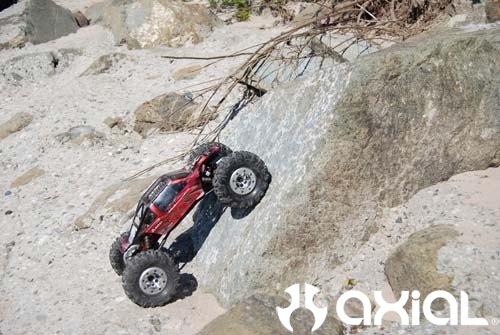
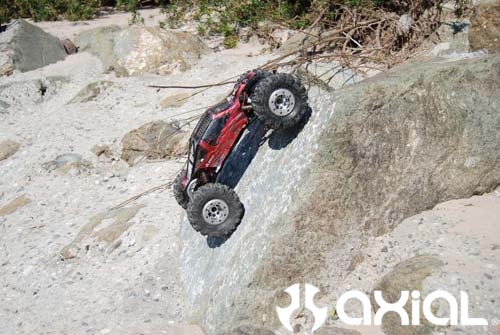
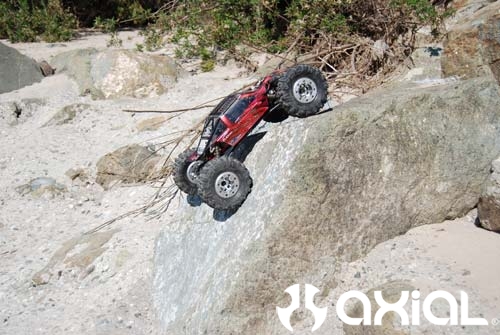
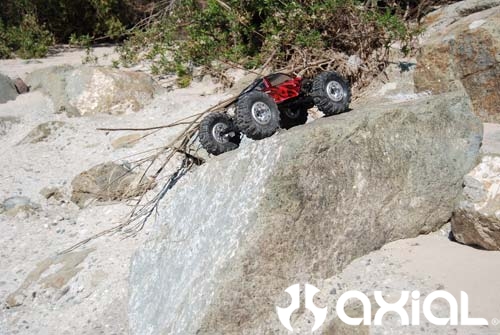
Off Camber:
Another common obstacle seen at most competitive R/C rock crawling comps is off camber situations. Gates are usually set-up on a steep face, and they will most likely require you to drive through them at an odd angle. Having too much travel on obstacles like this can hurt you too. All 4 tires will need to stay in contact with the obstacle for you to successfully negotiate it. Having a front tire lift on these off camber obstacles will pretty much guarantee you a one way ticket to the bottom of the obstacle before you clear the intended gate. Again, a shorter travel set-up will excel in situations like this, as long as the suspension isn’t set-up too soft. A lot of times there is a fine line between a shock set-up being too soft or too stiff. Ideally, you want the suspension to be as stiff as possible without it limiting your shock travel. That is why playing around with different shock pistons, springs and oil is so crucial when dialing a new rig in.
In this situation if my driver's side tires started to lift, I would probably roll off this ledge. Notice my foam set-up is very soft, maybe even too soft. But, this is my cold weather foam set-up and it was 80 degrees outside when I took these photos.
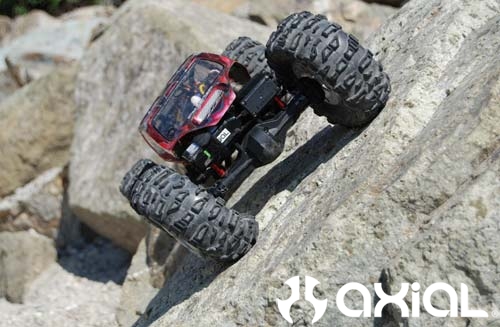
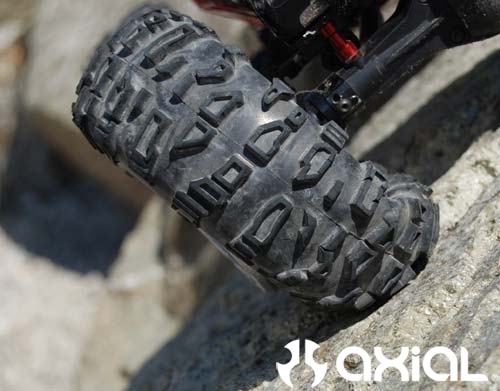
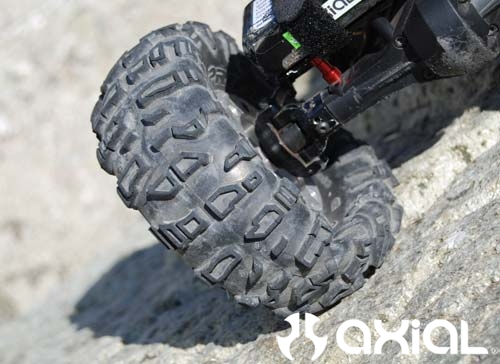
V-Notches:
V-Notches are another fairly common obstacle seen during comps. These obstacles have an entrance that is “V” shaped and that shape usually continues up a crack where the walls are about 90* to each other. These situations require you to keep your rig level as you drive up through. If you fall into the crack with your driver’s side, or passenger side, tires it’s usually tough to get back on line without using dig. Longer travel set-ups on obstacles like this will drop tires way down into the crack. Usually when this happens you are stuck in a position you don’t want to be in, and driving out of the dilemma will be very tough without taking a 10 point reposition penalty or several reverses. A shorter travel set-up will generally work better here, because if you do get off line and drop a tire in, the tire will only drop in so far. At this point you can usually steer into one side of the notch, or the other, to keep yourself level in the obstacle you are trying to clear.
Here you can see you want to keep your rig centered over the "crack" of the V-notch.
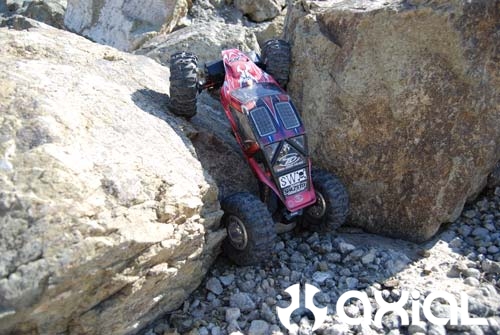
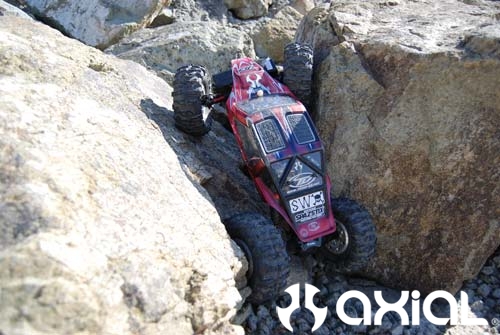
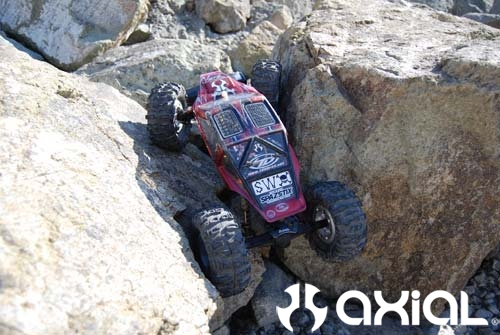
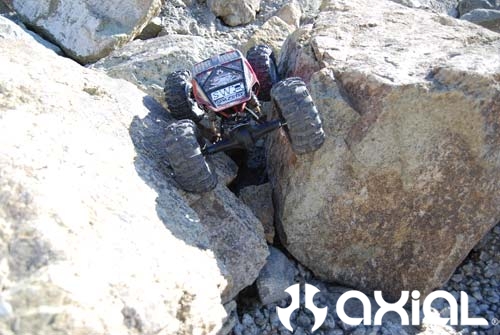
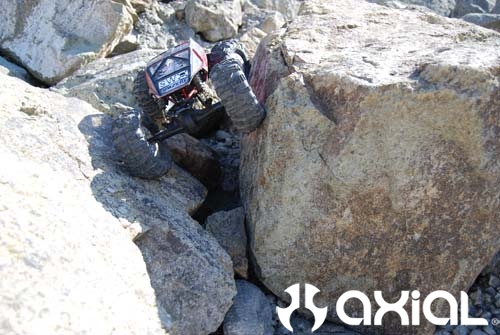
Holes:
Holes are another obstacle you will probably see a lot of in competitions. Gates are usually set-up so that one front tire and/or one rear tire drops into a hole or crack bigger then most 2.2 tires. Having too much articulation can hurt on obstacles like this too. A short travel set-up will be less likely to get caught in holes, because most times you can “float” a tire over a hole. A rig with a lot of travel will probably drop one tire completely into the hole, making it difficult to stay on line and clean the gate you are working on. Most times when a tire is swallowed up by a hole you will be forced off line. If a front tire gets caught the rear end usually walks out to one side as the captured tire tries to free itself. If a rear tire gets caught the front usually gets pushed or pulled off line as well. Having a suspension set-up that can float over holes will be a lot easier to drive in and out of situations like this.
At the end of the V-notch from the last paragraph was a hole that worked for this example. In these pictures you can see my front tire is floating over said hole on the passenger side, instead of dropping into it and possibly sucking my rig down into the crack with it. Having a well balanced rig in these situations will help too. If you run a ton of weight up front and none in the rear you may still flop down into the hole.
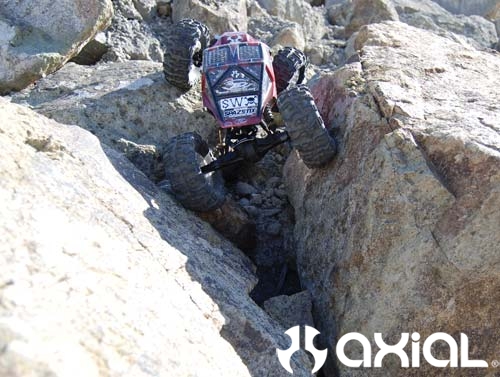
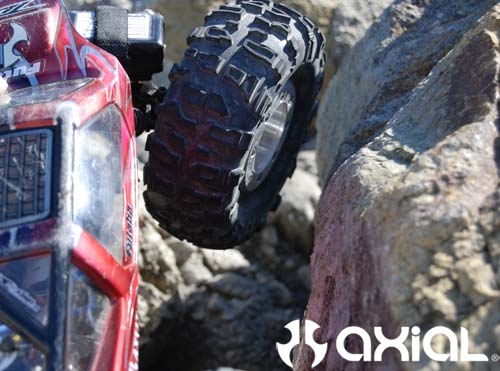
If that tire drops into this hole the outcome will be very tough to drive out of.
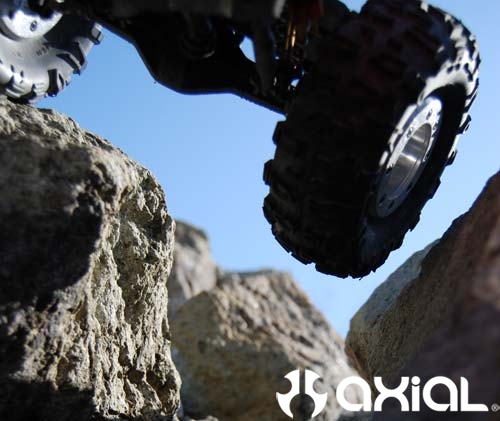
Once that tire drops, you will be looking at a situation like this. Easy to see that it will be harder to drive out of than the first picture.
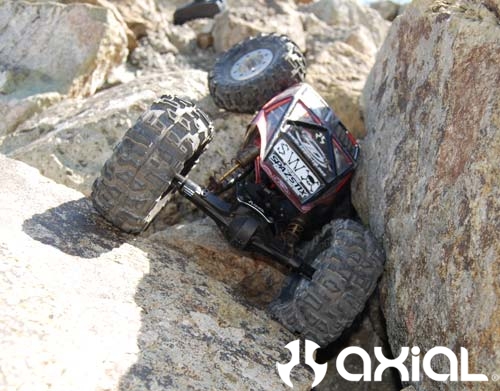
Conclusion:
Obviously, obstacles and terrain will vary quite a bit, as do rig set-ups and driving styles. So, not all of these scenarios I’ve brought up will be cut and dry. But, this should serve as a good basis for tuning a rig to have a little shorter travel than the average "new-comer "thinks they need. I personally build my comp crawlers to flex the height of the tire I’m running, and I always set the front suspension up a little softer then the rear. There are many factors in determining how capable a rig will be, like suspension geometry, ride height, weight distribution, tire choice, foam selection, shock tuning, etc. And there is no magic formula for building a crawler that has the potential to win competitions on your first try. But, playing around with different set-ups will help you learn what works for you, your vehicle and your terrain. Practice driving your rig as much as possible, and have fun while you do. Don’t be afraid to show up at a local comp to check it out and compete. 99% of the people I’ve met during R/C crawl comps are some of the nicest people I have ever met.